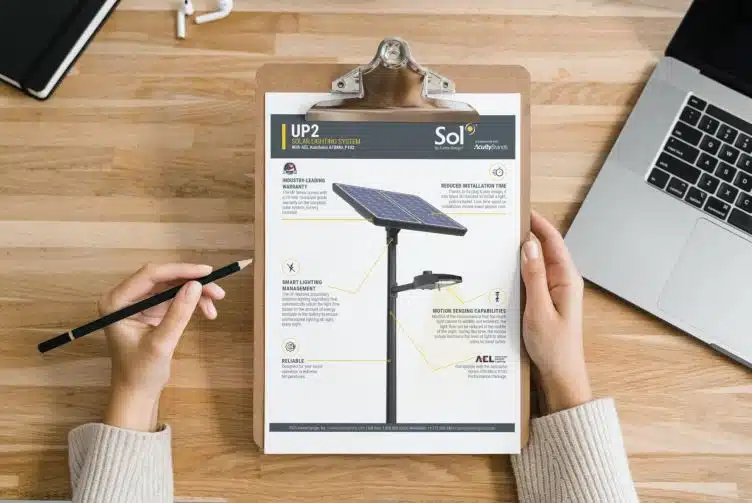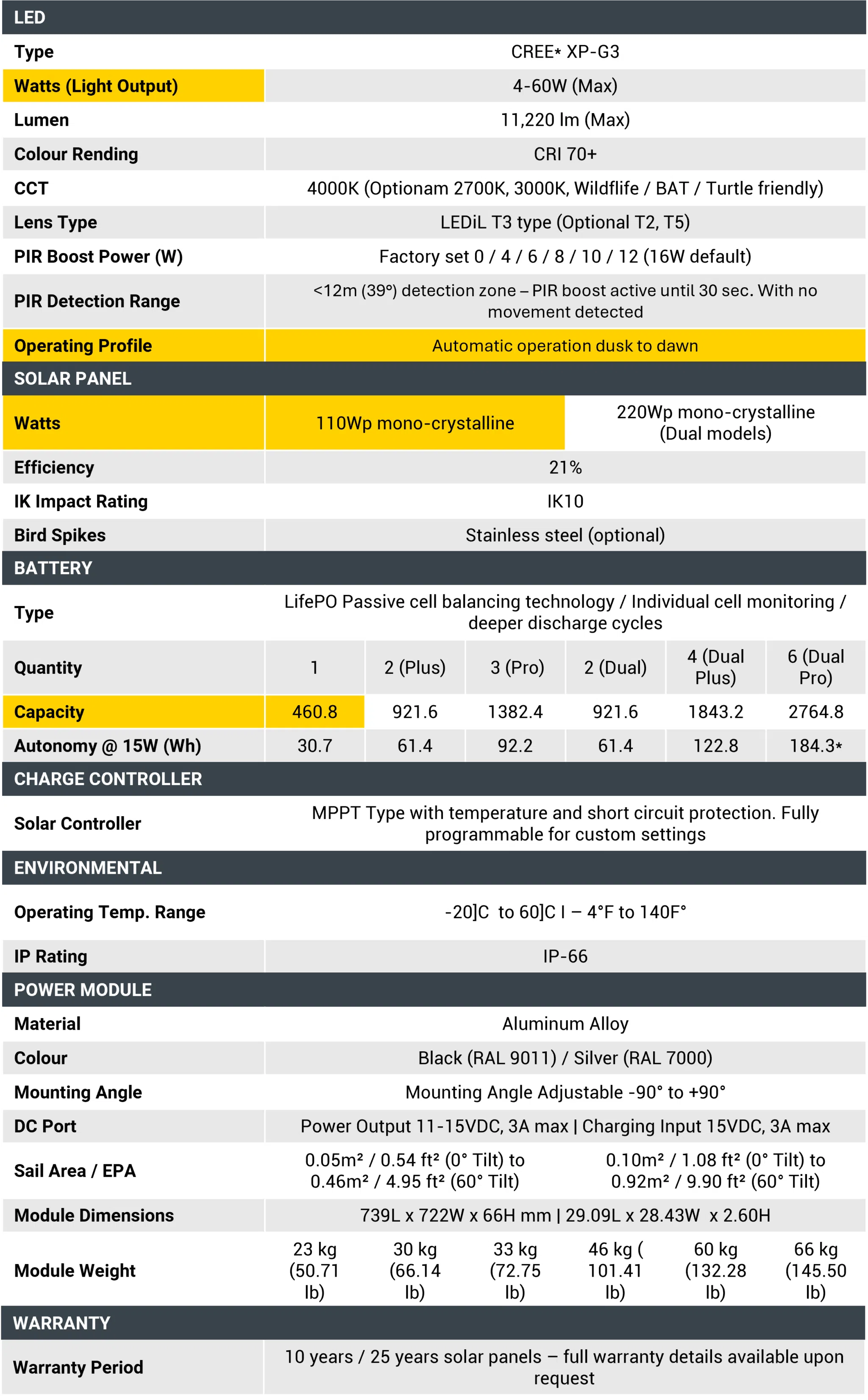Â
If you're considering solar lighting for your next project, you're on the right track. But choosing the right product and manufacturer can be tricky. Unlike buying an air fryer or a smartwatch, there's no one-size-fits-all guide for solar lighting—no CNET or Wirecutter. Instead, you'll need to rely on spec sheets.
Â
A spec sheet is like a product’s resume—it gives all the details you need to compare options and decide what works best for your needs. It also helps highlight what makes one manufacturer different from another, such as warranty terms, certifications, and testing standards.
Â
While spec sheets are essential, they can be overwhelming if you're not used to reading them. What do all those numbers mean? Which ones really matter? And how can you tell if a product is truly reliable? We’ve got the answers, so let’s break it down together.
Â
The info you actually need
Â
Here’s the good news: You don’t have to understand every detail on a spec sheet to make a smart decision. They’re full of technical information, but not all of it is relevant to your project.
Â
Your main goal should be to ensure the product will work for your project—specifically, whether it has enough solar power and battery capacity to run at the desired brightness for the required time. To check this, look for four key pieces of information:
Â
- Solar panel size (in watt-peak – Wp)
- Fixture output (in watts – W)
- Battery capacity (in watt-hours – Wh)
- Operating profile or run-time (how long the system needs to operate at a certain light level)
Â
Most spec sheets include these details, but some manufacturers might leave them out to hide less impressive specs. While missing data isn’t always a red flag, it’s worth asking questions if you can’t find the necessary information.
Â
Here’s an example of a spec sheet that includes the key points:
Â
Â
With these numbers, you can do some quick calculations to determine if a system will work for your project.
Â
Solar panel collection
Â
To figure out how big your solar panel needs to be, start by finding the average number of peak sun hours your location receives during the worst month. The NREL’s PVWatts Calculator is a great tool for this.
Â
Let’s say your project is in Charlotte, NC, where peak sun hours in December are about 3.73. Multiply that by the panel size in watt-peak (Wp) to get the maximum daily charging capacity.
Â
3.73 x 110Wp = 410 Wh
Â
But keep in mind that 3.73 is an average. On some days, you might get less sunlight. That’s why it’s important to use an array-to-load ratio (ALR), typically 1.2:1, to ensure the system can recover even on low-light days.
Â
410 / 1.2 = 341 Wh
Â
If you skip this step, your system might work well in summer but fail in winter when solar collection drops.
Â
Pro tip: Reputable manufacturers apply derating factors to account for dust, snow, shade, and temperature changes. These factors aren’t usually listed on spec sheets, but they’re important to ask about. If a company doesn’t consider them, the system’s performance may fall short of its claims.
Â
Fixture output and operating profile
Â
You now know how much energy is available, but you still need to calculate how much is needed to power the fixture. Use NOAA’s Solar Calculator to find the longest night for your location.
Â
In our example, it’s 14 hours. Then, check the spec sheet for the fixture’s output in watts. Most fixtures have a range (like 4-60W). If you have a lumen requirement, you can use the fixture’s efficacy to choose the right size.
Â
For instance, if you need 4,500 lumens and the fixture has an efficacy of 150LPW, you’ll need at least a 30W fixture (4,500 / 150 = 30W). Multiply that by the longest night to get the daily load.
Â
30W x 14 = 420Wh
Â
This is the amount of energy the solar panels must recharge each day. In our case, the 110Wp panel would not be sufficient because the max available load is only 341Wh.
Â
Don’t worry—it just means you need to adjust the system. For example, using a lower power setting in the middle of the night could reduce the load significantly.
Â
A 4D1 operating profile, where the light runs at full brightness for the first four hours, then dims to 50% for the next nine hours, and returns to full brightness before dawn, looks like this:
Â
30W x 5 = 150Wh
30W x 50% x 9 = 135Wh
Total = 285Wh
Â
This is under the 341Wh limit, so the 110Wp panel and 30W fixture would work with this schedule.
Â
Battery capacity and chemistry
Â
Batteries are crucial for solar lighting systems. They determine how long the system can run without recharging. A poor battery choice can lead to frequent failures, while a good one ensures long-term reliability.
Â
There are different types of batteries, like lead-acid and lithium. Each has its own recommended depth of discharge (DOD), which affects how much of the battery’s capacity can be safely used.
Â
Lead-acid batteries can be discharged up to 25%, while lithium can go up to 70%. Discharging beyond this can shorten their lifespan.
Â
Using the previous example, if the system requires 285Wh per night, you’d need at least 570Wh for two nights. With a lithium battery, you’d divide by 0.7 to account for DOD:
Â
570Wh / 0.7 = 814Wh
Â
If the battery only has 460.8Wh, you’d need two of them to meet the two-night autonomy requirement.
Â
A word of caution: Some manufacturers ignore recommended DODs, leading to undersized systems that fail quickly. Always check the specs carefully.
Â
Other considerations
Â
Now that you understand the basics of solar sizing, you can better assess whether a system will work for your project. But before making a final decision, here are a few other things to look for on the spec sheet.
Â
Warranty
Â
Even with grants or funding, solar lighting is a significant investment. A good warranty provides peace of mind, ensuring you can return, replace, or repair a faulty system.
Â
Most spec sheets list warranty terms, such as “5-year limited†or “10-year.†Be sure to check what’s covered. Many offer full coverage on the system but only partial on the battery.
Â
>>Sol proudly offers a 10-year warranty on all its solar lighting systems, including the battery.
Â
Certifications and testing standards
Â
Certifications like IEC and IEEE help verify a product’s quality and compliance. They’re especially useful for checking safety and performance claims.
Â
Another important test is LM-79, which measures LED performance. It’s the only standardized test that verifies a fixture’s actual output and efficiency.
Â
>>Learn more about LM-79 and efficacy
Â
Fixture characteristics
Â
Fixtures vary depending on whether the manufacturer builds them in-house or uses third-party components. Both approaches have pros and cons, but neither guarantees quality.
Â
We recommend working with established manufacturers like Acuity Brands, who have a proven track record of delivering high-quality, durable fixtures that last over 100,000 hours.
Â
Wrapping up
Â
Reading solar lighting spec sheets can feel overwhelming, but with the right knowledge, it becomes manageable. This guide should help you navigate the process with more confidence and make an informed decision.
Â
Have any questions about spec sheets or anything else? Our team of solar lighting experts is here to help.
Â
Extruded Fin Tube,Extruded Fin Pipe,Aluminium Extruded Fin Tube,Copper Extruded Fin Tube
Simcan Industrial Equipment Co.,Ltd. , https://www.simcanindustry.com

